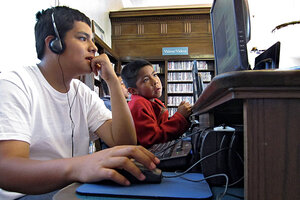Public libraries fight to stay relevant in digital age
Already facing tight budgets, public libraries are also contending with a cultural shift from traditional stacks of books to digital devices. But far from fighting the digital revolution, libraries are joining it.

Miguel Lopez (l.) watches videos with a friend on a public library computer in Denver. The city is threatening to shutter half its libraries.
Kristen Wyatt/AP
These days, it isn't business as usual at the Garden City Public Library in Michigan. The building is intact and the collection of books is in good shape, but no staff or patrons are on hand. That's because the library, which is just outside Detroit, closed its doors on June 17.
"It just floors me that this has come to happen here," said the library's director, James Lenze, the day before the closure. He attributed the shutdown to a reorganization of the town's financial priorities in a tumultuous economy.
The local institution is just one of America's public libraries that has struggled in recent years to stay afloat. A majority of states have reported library closures in the past 12 months, according to the American Library Association. While most of those states estimated that one or two branches shut down, some reported five to 10 closing their doors, which ALA says is part of a trend.
Many more libraries have tried to stay open by cutting back on operating hours.
While there is no question that tight government budgets have been a big factor in these reductions, some people point to a shift from traditional stacks of books and periodicals to digital devices that can be used for reading and information gathering.
Yet many librarians, vowing to avoid the fate of the Garden City library, are not taking these problems lying down. Far from fighting the digital revolution, they're joining it by greatly expanding libraries' electronic offerings. They're also emphasizing some of the free things in a library that go beyond books – including children's programs and an experienced staff that can help with everything from research to job hunts.
It's all an effort to try to ensure that such institutions are a vibrant and relevant part of communities, which could then make it harder for funding to be cut or for buildings to be closed.
"A physical library is more than just a collection of books," says Alan Inouye, director of ALA's Office for Information Technology Policy in Washington.
In the past few years, more than 66 percent of US libraries have expanded their digital offerings, ALA says. The most common step: giving patrons the ability to browse virtual stacks and download titles to electronic devices.
Access to digital resources has been the fastest-growing area of use for the District of Columbia Public Library system, says Ginnie Cooper, its chief librarian. Both the Washington and New York City public-library systems face 40 percent cuts in the coming fiscal year.
According to a recent ALA report issued by Mr. Inouye's office, it is vital that libraries adapt to the shift in how patrons seek resources.
"The purely physical library is no longer strategically realistic," the report reads, adding that while most public libraries are maintaining their physical branches, they are increasingly being drawn toward the "virtual endpoint."
In addition to making technological strides, librarians are stressing the many free resources available to patrons. With more adults out of work and money tight, the library is a place where people can conduct employment search efforts and even continue with leisurely endeavors.
Indeed, more Americans have been turning to libraries for job-search and financial-literacy assistance, says Ann Thornton, acting Andrew W. Mellon director of the New York Public Libraries. Officials in that system stepped up both of those services with the onset of difficult economic times.
"Ironically, just at the time when our users need us more, budgetary constraints and the uncertainty of city funding for the library make keeping up with demand difficult," Ms. Thornton says.
Of course, local libraries also hold children's programs, community meetings, classes, and events.
For example, while patrons of the South Brunswick Public Library in New Jersey can download its holdings from just about any location with an Internet connection, there is still a steady flow of visitors to the facility for community programming and meetings, says Mary Donne, head of information services at the library.
For Ms. Cooper, going to the library is a community occasion. "I think that coming together of the community ... that is part of what the library's role is, and I think that is what brings people to us."
As for Mr. Lenze and the seven other staffers at the Garden City library, a November ballot question could allow voters to reopen the library.
For now, the 7,000-plus registered patrons of the Garden City institution can opt to pay nonresident memberships at libraries elsewhere. According to the Garden City library's website, the closest towns charge between $45 and $75 for annual cards for individuals and $100 for households.
"They're finding now what those costs [of membership] are, and it greatly exceeds what we were asking them [in tax dollars] to keep the library open," says Lenze.
